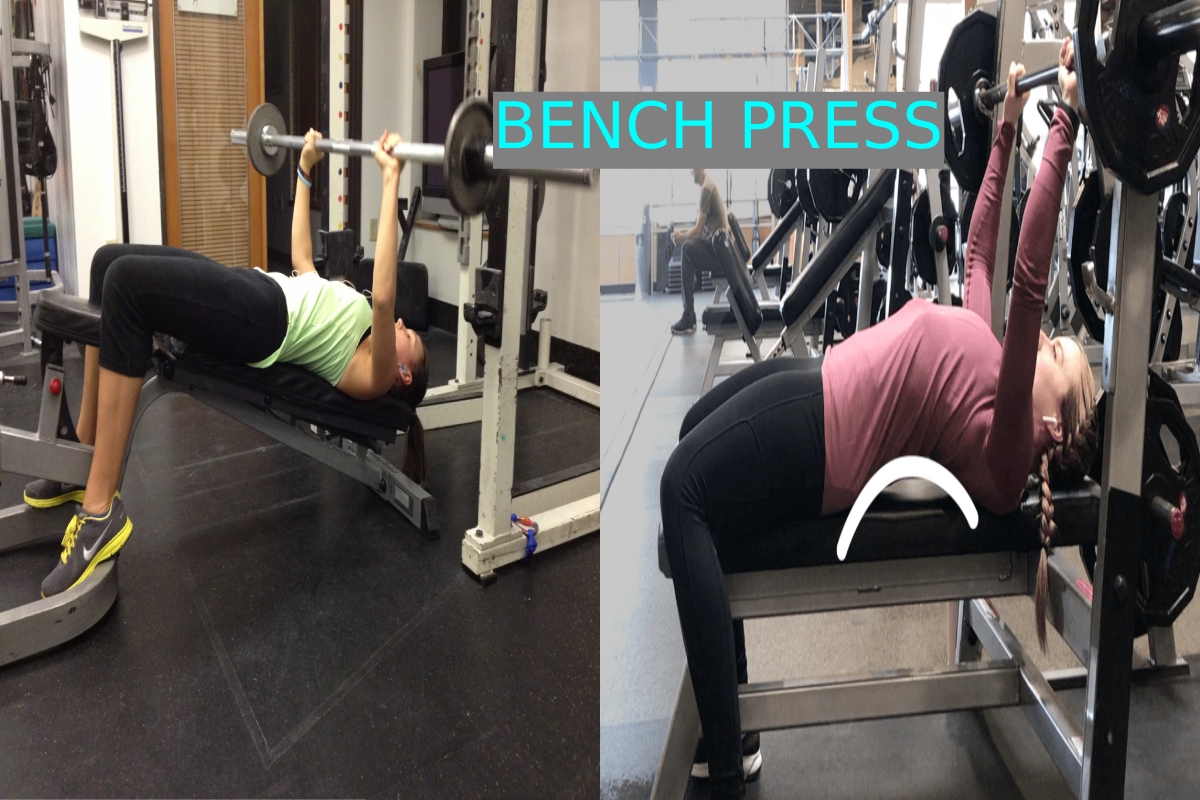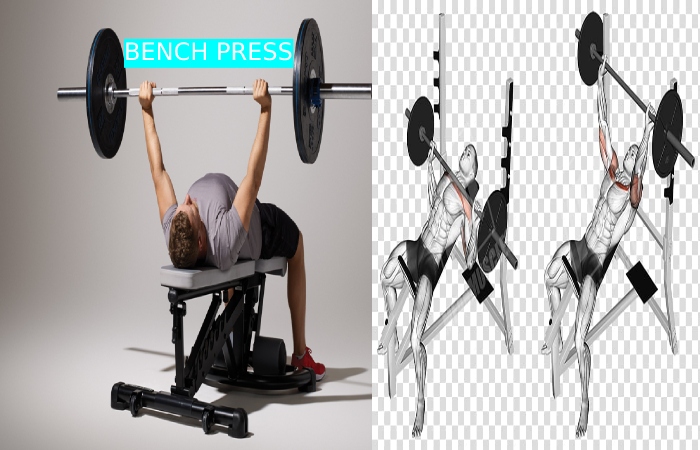Table of Contents
Bench Press – Explanation
Bench press helps build many muscles in the upper body. You can do this workout with either a barbell or dumbbells. Perform bench presses frequently as part of an upper-body workout for increased strength and muscle development.
Including Bench Presses into your Routine
If you want to add seat journalists into your weightlifting routine, try to do seat journalists only two to three times per week. Give by hand at least a day between doing bench journalists to allow your muscles to heal.
The number of reps you perform per session depends on your fitness goals. If you are using hefty weight, doing just 3 to 5 reps at a time may be sufficient to be effective. You can perform up to 3 sets, inactive for a few minutes among groups.
If you’re looking to build up circulatory fitness, you can perform an advanced number of reps — about 5 to 10 — with a lower weight.
On chest and back days, other exercises you might want to do include bent-over rows, chin-ups, and diamond push-ups.
For a full-body workout, spend another day directing on legs and shoulders by doing squats, lunges, and overhead presses. You should also include circulatory exercises like running, swimming, or cycling in your weekly routine.
Following this type of varied routine is vital for making sure you are working your entire body. This weekly routine also lets you income rest days to allow different strengths to recover.
Full-body routines can also be more actual than spot training or execute the same exercise to build up that muscle. Recollect, your body quickly adapts to exercise, so switching up your workouts is essential to keep your body challenged.
How to Do a Bench Press
A standard flat bench can be used if you don’t have access to a specialized bench press rack. You can also do bench journalists with dumbbells or a barbell. Either you choose, be sure to choose the suitable weight for you.
Lie on the bench, under the rack that holds the bar. Your butt, shoulders, and head are flat on the seat with a neutral spine. Your eyes should be unevenly affiliated with the front of the barbell rack verticals.
If your feet are not securely flat on the floor, use blocks or weight plates under your feet slightly than employing your legs on the bench, which decreases constancy.
Draw your shoulder edges back behind you to keep insistent with round accepts.
Grasp the barbell using an overhand grip, insertion your thumbs on the outside of your closed fist. Your arms are somewhat wider than shoulder-width apart, and the angle of your upper arms is about 45 grades to the form.
Eliminate the barbell from the rack, locking your elbows.
Inhale while dropping the bar to your chest, at the nipple line.
Respire as you press the bar above your chest, covering your arms. Don’t watch the bar—focus on the ceiling.
Lower the bar, so it is just upstairs your chest. This is the initial position for the next bench press.
Benefits of Bench Presses
Bench presses are an exercise that can be used to tone the muscles of the high body, including the pectorals, arms, and shoulders.
Depending on your goals, different bench presses work slightly different muscles, too. For example, a slimmer grip bench press also works the triceps and alerts.
Other benefits Trusted Source of adding bench presses to your weight-training regimen include increasing upper body strength, improving muscular endurance, and preparing your upper body to do movements like push-ups. They also can be an effective establishment exercise for sports like sprinting, hockey, and football.
Tips of Bench Press
The bench press is multiple exercises that include the pectoralis major of the chest, the forward deltoids of the shoulder, and the triceps brachii of the upper arm.1 It builds strength and encourages these muscles’ growth.
Muscle growth is desired by bodybuilders and benefits everybody as muscle mass classically failures with age. The bench press is a helpful exercise that effortlessly helps you do daily activities that require forceful or booming.
The bench press can help return muscle balance for participants who mainly use dragging muscles.
This includes wrestlers, rock climbers, and swimmers. The barbell bench press is also an inexpensive lift in powerlifting, the other two being the deadlift and squat.
Effect do Bench Press Variations have on the Muscles
Each bench media difference works for slightly different muscle groups. Variations include
Old-style seat press. This exercise is done deceitfully on a flat bench and insistent a barbell up and down at chest height. It works the pectoralis muscles, shoulders, and arms.
Incline bench press. It marks muscles of the upper chest and shoulders. For this difference, the front of the bench is square between 45 and 60 grades, so you are leaning back slightly.
Decline bench press. For this variation, the front of the bench is angled upward, so when you lie unhappy, your feet are in a higher situation than your head. It works the lower chest strengths and shoulders.
Good grip bench press. It works the triceps and forearms. During this dissimilarity, your hands are slimmer together on the barbell.
It’s unnecessary to do all of these variations in the same test. Misusing a muscle group can lead to injuries. That’s particularly true if you’re working with heavyweights.
If you like change, you can pick two differences per workout. Try to give by hand a rest day allowing muscles to recover before swapping between the other variation
Equipment Needed in Bench press
barbell level bench
Lie on your back on a flat seat. Grip a barbell with hands somewhat more expansive than shoulder-width.
Press your feet inflexibly into the crushed and keep your hips on the bench throughout the entire drive.
Gradually lift the bar off the rack, if using, and lower the bar to the chest, permitting elbows to bend out to the side.
Stop lowering when shoves are just under the bench. Media feet into the floor as you push the bar spinal up to reappearance to starting situation.
Achieve 5-10 reps, dependent on the weight used. Perform up to three sets.
Narrow grip bench press
Other Variations of the Bench Press
You can perform this exercise in many ways to meet your fitness level and goals.
Partial Bench Press
If you have any apprehensions about shoulder joint constancy, don’t lower the weight so far that the top part of the arms falls below parallel. While you may not benefit from the full range of motion, this modification places less stress on the shoulder area.
Common Mistakes in Bench Press
Avoid these common mistakes to keep your bench press safe and effective.
Moving Bar Over the Mouth or Neck
Make sure the bar’s path is not too low—over the mouth and neck region—when racking or unracking it. This means that you should move the weight to and from the rack from an arms-extended position, not low across the neck and face.
Improper Grip Thickness
Your grip on the bar must usually be wide enough to have your elbow joints at right angles (at a minimum) and forearms in a perpendicular plane. If your grip is too broad and your elbows too flared out, you risk injuring your pectoral muscles.4
Incorrect Thumb Position
Another grip-based mistake includes thumb location. Your hand grip should be overhand with the scans placed under the bar and crossways the top of the fingers. Don’t home the thumbs behind the bar or locked beneath the fingers.
Locking Elbows Suddenly
Contrary to some weightlifting safety information, you can “lockout” your elbows when doing a bench press.5 The key to making this action safe is not to lock the elbows out unexpectedly or explosively.
Pushing Head Into Bench
Keep your head even on the bench and feet flat on the floor for constancy, but don’t push your head into the bar to assist the lift—firm up the neck muscles in its place.
Arching Back and Lifting Behinds
Your buttocks should continue flat on the bench through the press. Don’t match the powerlifter style of arching your back so much that your buttocks lift off the court.6 If you do, this can result in low back pain.
Conclusion
If you have any injury to your shoulders, you must evade this exercise. If you feel any shoulder pain during the bench press, replace the weights and immediately end the movement.
Apprentices can benefit from doing presses without weight to sincere up, get a feel for the bar, and absorb suitable methods. If you are more advanced and, thus, seat insistent a heavyweight, do so only with the assistance of a spotter.
It is also good to use an influence rack if pressing heavyweights. This type of stand has bars on either side, set at your chest level. This way, if your lift fails, the blocks stop the barbell from severe your chest.
Jump with three sets of 10 reps utilizing an unweighted barbell. Once you can perform this exercise safely and with good form, begin to add weight. Each week, add 2.5 pounds to each side of the bar.


